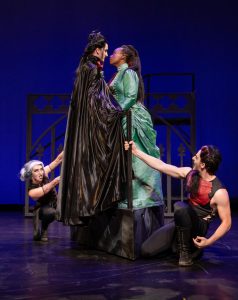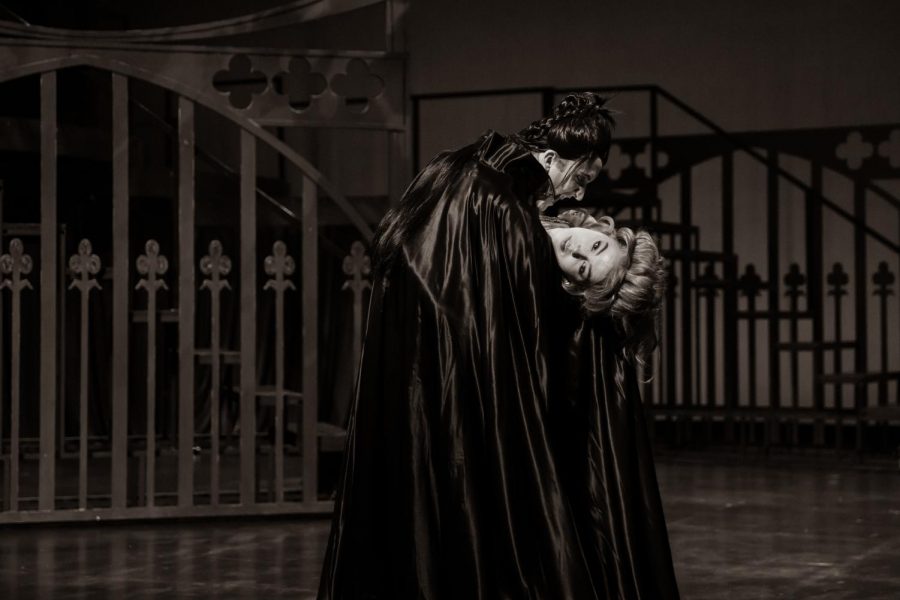Good Theatre and Good Monsters: The U of U Theatre Department’s ‘Dracula, the Musical’
Count Dracula transforms Lucy into a Vampire. (Courtesy of the University of Utah Theatre Department.)
September 17, 2019
From Homer’s fearsome beasts to Victorian penny dreadfuls, Grimm’s fairy tales to 1980s slasher flicks, monsters appear everywhere throughout the history of storytelling. One can find Stephen King releases on one end of the globe and body horror mangas on another, monster-themed toys marketed to children and adults testing their gag reflexes with fantasy gore, and a number of strange creatures crawling between both the pages of religious texts and quests of video games. Monsters are exciting — whether we find their thrill from screaming at the sight of a Demogorgon, cheering on E.T.’s escape home or crushing on scaley fish-men and slimy parasites — yet few capture the irresistible terror and allure of all monsterkind has to offer so well as the cold, brooding and tastefully scary Dracula. Portrayed in hundreds of films and novels since his creation, the Count is practically synonymous with monster pop culture. Now, he is being portrayed by The University of Utah’s theatre department in their production of “Dracula, the Musical.”
Running through Sept. 22, “Dracula, the Musical” is the perfect show for anyone who is ready to get spooky ten steps ahead of Halloween. The musical closely follows the traditional plot of Bram Stoker’s “Dracula,” however, it places a uniquely increased emphasis on the relationship between Dracula himself (Chase Quinn) and Mina Murray (Talia Heiss,) his target of desire once he discovers her photograph and falls in love with her at first sight. After Dracula disastrously changes Mina’s closest friend Lucy (Hayley Cassity) into a murderous vampire such as himself in his attempt to seduce Mina, Mina’s newlywed husband Jonathan Harker (Matthew Rudolph) and three of Lucy’s suitors band together at the urging of Doctor VanHelsing (Cam Holzman), a brilliant but uncompromising vampire hunter, to slay Dracula. In the meantime, Mina — at once terrified of Dracula’s (literally) bloodthirsty nature and drawn to his promises of eternal devotion to her — must decide whether to join or betray him. After all, while she finds Jonathan to be a kind and doting companion, she isn’t in love with him and sees her marriage as imprisonment.
In a sense, “Dracula, the Musical” provides an inverse plot to the more popular “The Phantom of the Opera,” in that instead of portraying a heroine who is manipulated and held captive by a monstrous admirer, the musical instead depicts her potential choice to go out and pursue him. Frankly, this is a far more refreshing and provocative depiction of this type of romance, for as wonderfully imaginative as “Phantom” is as a piece of musical theatre, it nonetheless leans upon threads of toxicity and abuse at its center. Instead, Mina isn’t treated as a pawn in “Dracula, the Musical,” as she has been in previous adaptations, but as an active player who’s a character is just as complex and vivid as Dracula’s. Heiss lends her character stunning believability, particularly with her polished singing voice, while Quinn’s portrayal of Count Dracula remains true to the original vampire in over-the-top bravado.

However, while the story of “Dracula, the Musical” is thoroughly enjoyable, the production primarily stands out as a visual spectacle accomplished with professional-level craftsmanship. The sets of moving staircases, twisting bookshelves and flashing projections of clouds and lightning are wholly entwined with the production’s choreography. Actors clamber around and across pieces which an ensemble of emotive dancers spin and turn through clouds of hazy fog and multiple colorful spotlights.
Even the typically more simple scenes are converted into nonstop displays of movement and action, transforming this Gothic drama into a tense thriller. The staging is some of the best I’ve ever seen, not only from any of the theatre’s department’s productions but from any I’ve seen across the state of Utah. Despite the smaller scale, this production is certainly on the level of works I’ve seen from professional companies, such as Hale Center Theater. The room practically vibrates with the energy of the rock-opera-inspired score’s live instrumentals of electric guitar and drums. Outside of seeing the show itself, you can even request a virtual reality viewing of one of the show’s songs — created by the theatre department in collaboration with the Marriott Library — to experience a more individualistic, immersive theatre experience of what it feels like to be on stage with the performers.
To those who consider themselves both fans of dramatic theatre and light show concerts, you’ll be delighted to find that “Dracula, the Musical” successfully fuses the best of these forms together into a singular, electrifying production. Sure, naysayers might claim that good plays shouldn’t find their allure from the atmosphere so much as a compelling script. Admittedly, the plot of “Dracula, the Musical” does cut as abrupt and campy at times, but aren’t these the very traits which draw audiences to the story of Dracula in the first place?
Lastly, it is worth noting that though nothing so harsh as strobe lights are used in this play, those who are likely to feel unwell from looking at bright and flashing lights for long periods of time — such as individuals who are prone to seizures or with a history of vertigo — should take some precaution in considering whether to attend this show. I felt dizzy and physically nauseous after walking out of the theatre, as if I’d gotten off of a roller coaster with loop-the-loops. While I personally found this rush appealing, it is possible that others more sensitive to such effects may experience a more severe reaction towards this play.
Tickets are free for all U students and cost $8.50 for other students, $15 for seniors, military and U staff and $18 for general admission. Seats may be purchased in advance online, and purchased or reserved at the Kingsbury Hall box office, the Student Union and at the door, if there’s room left for more audience members. For scenes of fantasy violence, allusions to sex and depictions of seduction, the show is recommended for audience members 14 and over.
An earlier version of this review misidentified a character and actor. The character’s name is Doctor VanHelsing, and the actor’s name is Cam Holzman.











